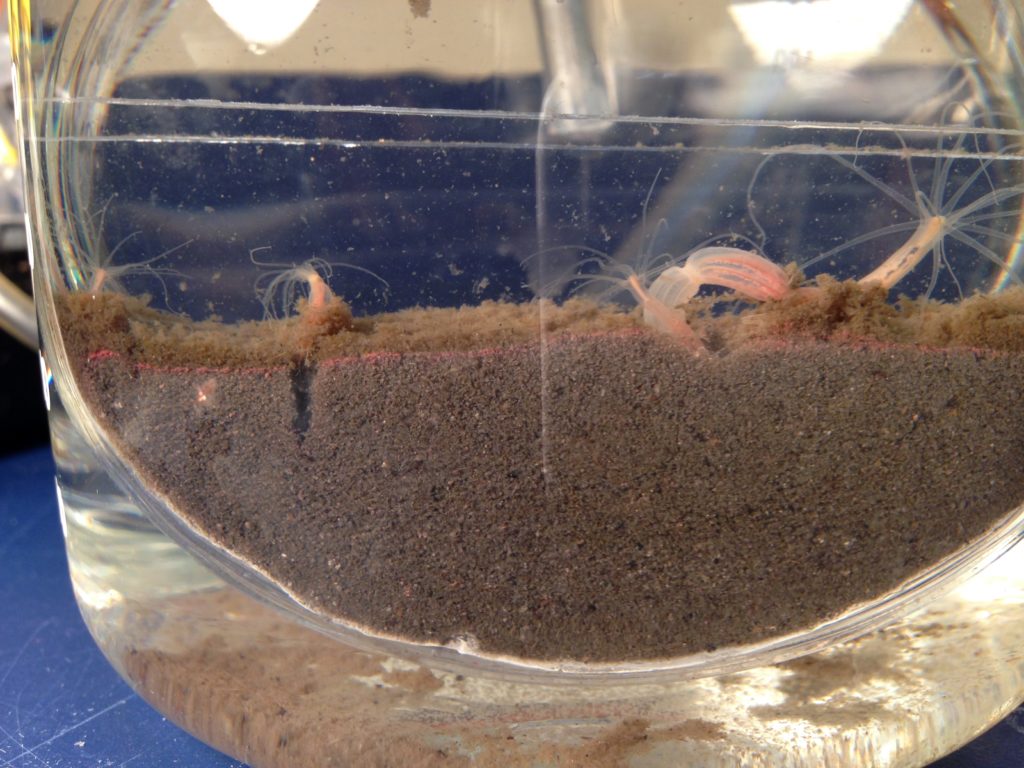From Runway to Reality: A model organism in its natural habitat

Of all the scientists studying mice and fruitflies, the vast majority aren’t really motivated by an undeniable interest in rodents and insects. Because these animals are easy to raise and manipulate experimentally, scientists use them as models to study complicated aspects of genetics, development, physiology and behavior. In particular, many studies take advantage of features that are shared between the model organisms and humans. We often study mice and fruitflies to learn more about human health. Essentially any species can be developed as a model, and the most appropriate models depend on the questions being asked. Our lab has focused for several years on the starlet sea anemone Nematostella vectensis.
Nematostella has a lot of things going for it. It’s easy to grow in the lab. It spawns readily, enabling developmental studies and genetic manipulations. It can also be propagated clonally, allowing the use of genetically identical individuals in experiments. Nematostella is part of the Phylum Cnidaria, which diverged from bilaterian animals hundreds of millions of years ago. By comparing cnidarians with bilaterian animals, we can better understand how animals evolved and diversified. But that doesn’t tell us anything about how this animal makes its living in the real world.
Should we care? Is there anything to be gained by studying lab models…like mice or fruitflies or Nematostella…in their natural environments? As you might guess, I think there is a lot to learn from this approach.
What have others learned?
The laboratory of Dr. Hopi Hoekstra studies natural populations of rodents to better understand the underlying evolutionary mechanisms. In one set of studies, Weber, Peterson and Hoekstra identified the genetic basis for burrowing behavior in sister species of mice. This work required careful field observations to obtain a detailed understanding of the natural history of each species, particularly as related to burrowing behavior. They then conducted detailed laboratory breeding studies followed by genetic marker characterization (ddRAD) and statistical analysis (QTL, quantitative trail loci) to identify specific parts of the genome associated with burrowing characteristics. Now mouse burrows are all fine and good, but this work is really of interest because it provides an explanation as to how complex animal behaviors can develop and evolve. In this case, dramatic changes in burrow architecture can result from a small number of genetic changes…digging an escape tunnel appears to be associated with changes to a single genetic region. Also of interest, different features – digging long entrances and escape tunnels – appear to have evolved independently. This indicates that a complex behavior can be built in a modular way, piece by piece.
An example closer to my heart (I have a soft spot for circadian rhythms) is studies of circadian adaptations within natural Drosophila populations. Lots of scientists have studied mutations in various circadian regulatory genes in Drosophila in the lab, and this has taught us a great deal about clock function. A particularly interesting set of observations were made in the early 1990s by Costa, Kryriacou and colleagues. They found that variations in the length of the Drosophila clock gene were strongly associated with a latitudinal cline extending from North Africa up into Great Britain, and that these alleles conferred differences in thermal stability of the clock. Similar latitudinal clines have now been found in core clock genes of other species, particularly migratory salmon and songbirds.
So what could we do with Nematostella?
Like many others, we typically rear Nematostella in glass dishes under pretty standard conditions. But the real world is quite different from a Pyrex bowl. In nature, Nematostella burrows into sediments of tidepools. They can experience and tolerate large changes in temperature, salinity, light and water chemistry. What about their genetic makeup allows them to be so tolerant when many other cnidarians are more sensitive? By studying Nematostella in a range of complex natural environments, we hope to learn more about how it has adapted over the centuries, and, on much shorter time scales, how it is able to acclimatize to such variable conditions.
We are also working on bringing a little bit of the field into the lab. For example, we still don’t know very much about the burrowing behavior of these animals. By studying their movements within natural sediments (see our prototype Nematostella “ant farm”), we hope to answer some very basic questions:
How does Nematostella respond to stressful conditions? …do they burrow more deeply to avoid predators or UV radiation?
How the lifecycle is regulated? Are there tactile cues for asexual reproduction? …we think there might be
How do they affect their environment? Does burrowing behavior by this small animal significantly contribute to biogeochemical cycling in the sediments?
…And perhaps my favorite…why do these animals have a circadian clock? How and why does their behavior and physiology change on a daily cycle? Is a circatidal clock superimposed on the circadian clock? We know there are daily behavioral cycles in the lab, but we plan to use sediment microcosms to characterize more realistic behaviors.
We’re still thinking about all the questions we might approach by studying this animal in its natural environment (or at least a more realistic laboratory environment). We appreciate other suggestions and would be interested in hearing about other experiences in moving model organisms from “runway to reality”
A couple references:
(Mouse burrowing behavior)
Weber JN, Peterson BK, Hoekstra HE. 2013. Nature 493.7432: 402-405.
(Drosophila clock cline)
Costa R, Peixoto AA, Barbujani G, Kyriacou C P. 1992. Proc Royal Soc B 250, 43-49.